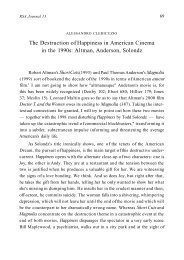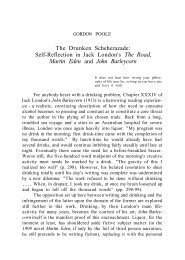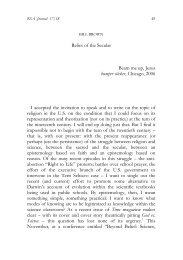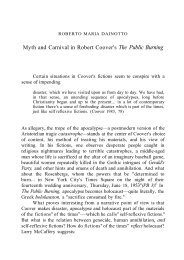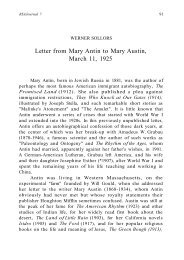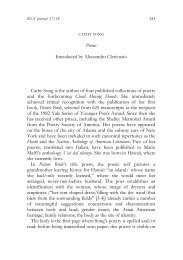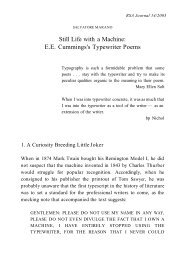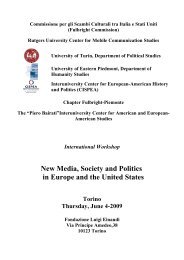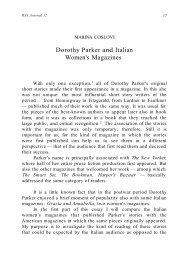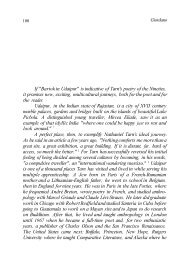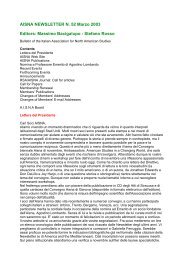An American Jeremiah in Rome: A Study of Margaret Fuller's ... - aisna
An American Jeremiah in Rome: A Study of Margaret Fuller's ... - aisna
An American Jeremiah in Rome: A Study of Margaret Fuller's ... - aisna
- No tags were found...
You also want an ePaper? Increase the reach of your titles
YUMPU automatically turns print PDFs into web optimized ePapers that Google loves.
RSA Journal 11 123<br />
attitude towards her subject, however, the critical consensus among U.S. scholars,<br />
reiterated <strong>in</strong> William L. Vance's detailed study <strong>of</strong> <strong>American</strong>s' reactions to the<br />
Risorgimento <strong>in</strong> America's <strong>Rome</strong> (New Haven, Conn.: Yale UP, 1989), 2, pp. 105-210,<br />
is that the Tribune dispatches differ considerably from other n<strong>in</strong>eteenth-century<br />
recreations <strong>of</strong> Italy. Interest<strong>in</strong>gly, the one dissent<strong>in</strong>g voice is that <strong>of</strong> Italian scholar<br />
Rosella Mamoli Zorzi, who, <strong>in</strong> the <strong>in</strong>troduction to her translation <strong>of</strong> the Tribune<br />
dispatches, argues that <strong>Fuller's</strong> account <strong>of</strong> Roman republic has "typically <strong>American</strong><br />
traits", whether it be faith <strong>in</strong> <strong>American</strong> democracy or Protestant prejudice aga<strong>in</strong>st<br />
the Catholic church (Un <strong>American</strong>a a Roma, 1847-49 [Pordenone, Studio Tesi,<br />
1986], p. xiii), While Mamoli Zorzi does not address the issue <strong>of</strong> <strong>Fuller's</strong><br />
nationalism explicitly, her essay, like m<strong>in</strong>e own, is an example <strong>of</strong> the analytical<br />
advantage conferred upon foreign scholars <strong>of</strong> <strong>American</strong> culture by their position<br />
<strong>of</strong> cultural marg<strong>in</strong>ality, which enables them to be aware <strong>of</strong> ideological systems<br />
<strong>of</strong>ten <strong>in</strong>visible to native scholars.<br />
5 Bell Gale Chevigny, "To the Edges <strong>of</strong> Ideology: <strong>Margaret</strong> <strong>Fuller's</strong><br />
Centrifugal Evolution", <strong>American</strong> Quarterly 38 (1986), p. 190.<br />
6 Chevigny, The Woman and the Myth: <strong>Margaret</strong> <strong>Fuller's</strong> Life and Writ<strong>in</strong>gs<br />
(New York: Fem<strong>in</strong>ist P, 1976), 376.<br />
7 Rosella Mamoli Zorzi and Larry J. Reynolds first observed that <strong>Fuller's</strong> use<br />
<strong>of</strong> the European scene to <strong>in</strong>dict America could be called a jeremiad <strong>in</strong>,<br />
respectively, "II viaggio di un'americana <strong>in</strong> Italia: <strong>Margaret</strong> Fuller", <strong>in</strong> Viaggio e<br />
scrittura. Le straniere nell'Italia dell' Ottocento. ed. Liana Borghi, Nicoletta Livi<br />
Bacci and Uta Treder (Geneve, Slatk<strong>in</strong>e, 1988), pp. 119-26 and European<br />
Revolutions and the <strong>American</strong> Literary Renaissance (New Haven, Conn., Yale U.P.,<br />
1989), pp. 54-78. While my analysis is <strong>in</strong>debted to their description, it differs from<br />
it <strong>in</strong> that I stress the fundamentally celebratory and nationalistic nature <strong>of</strong> the<br />
jeremiad rather than its critical import.<br />
8 Several readers have noticed the contrast between <strong>Fuller's</strong> public and<br />
private accounts <strong>of</strong> Italian liberalism, most recently Larry J. Reynolds and Susan<br />
Belasco Smith <strong>in</strong> their "Introduction" to the Yale U.P. edition <strong>of</strong> the Tribune<br />
dispatches, especially pp. 30-1. Unlike these critics, who have found <strong>Fuller's</strong><br />
private censure <strong>of</strong> the Roman republicans <strong>in</strong>compatible with her public stance, I<br />
f<strong>in</strong>d her unpublished negative comments consistent with her public adoption <strong>of</strong> a<br />
mode <strong>of</strong> social criticism that reaffirms <strong>American</strong> republican exceptionalism.<br />
9 As examples <strong>of</strong> <strong>Fuller's</strong> social criticism <strong>in</strong> the New- York Daily Tribune, see<br />
"New Year's Day" (1 January 184S); "Oneota; or, The Red Race <strong>in</strong>America ", by<br />
Henry R. Schoolcraft" (12 February 1845); "Our City Charities" (19 March 1845);<br />
"Prevalent Ideas that Politeness is Too Great a Luxury to be Given to the Poor" (31<br />
May 1845); "Narrative <strong>of</strong> the Life <strong>of</strong> Frederick Douglass" (10 June 1845); "Asylum<br />
for Discharged Female Convicts" (19 June 1845); "1st January 1846" (31 December<br />
1845); "The Rich Man—<strong>An</strong> Ideal Sketch" (6 February 1846); "The Poor Man—<strong>An</strong><br />
Ideal Sketch" (25 March 1846); "What Fits a Man to Be a Voter" (31 March 1846);<br />
"Memoirs, Official and Personal, with Sketches <strong>of</strong> Travel among the Northern and<br />
Southern Indians ", by Thomas L. M'Kenney (8 July 1846); "Victory" (21 May 1846).



